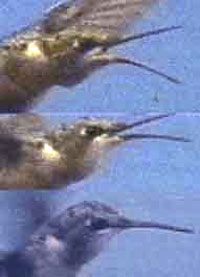For more archives, go to the Advance Archive/Search Page.
Hummingbird's Beaks Bend To Catch
Insects, Researchers Say
Hummingbirds' beaks are closely adapted to the shapes and sizes of the flowers on which the birds feed. But at first glance they appear ill suited to the task of catching insects, a source of protein without which the birds would die.
 |
Gregor Yanega, a Ph.D. candidate in ecology and evolutionary biology, sets up a flight cage and high-speed video camera to observe hummingbirds' feeding mechanisms at La Selva Biological Station in Costa Rica.
|
Two UConn scientists recently discovered that hummingbird beaks have a special mechanism that helps them catch flies: they bend.
The Right Tool
"Hummingbirds are a textbook case of co-evolution, the fit
between birds and flowers," says Margaret Rubega, an assistant
professor of ecology and evolutionary biology and co-author
of an article about the research that was published in Nature
in April. "But a long skinny beak is not the best tool for insect
eating."
Using the right tool is vital, she says: "If you've got a fly in the house, you don't use tweezers. You get a swatter or a newspaper, to compensate for the fact the fly can move fast to avoid you."
Most birds that are insectivores have short, wide beaks. The hummingbird study - part of the Ph.D. research of graduate student Gregor Yanega, first author of the paper - began from the question: How do these nectar-feeding birds catch insects at all?
 |
High-speed video images show a ruby-throated hummingbird bending its lower beak to catch a fly. |
Using high-speed video to study three species of hummingbirds, the researchers observed that the birds bend their lower beak downward by up to 20 degrees. The movement effectively opens the beak wider, and increases the bird's ability to catch an insect in its mouth rather than at the tip of its beak.
Yanega and Rubega found that hummingbirds also flex the lower jaw laterally at the same time, to widen the area at the base of the beak.
"Being able to bend the lower jaw vertically and laterally seems to allow a bird with narrowly set jaws to have an effectively larger mouth," says Yanega. "It's a fascinating morphological solution to the problem."
The findings were a surprise. "If anyone had said hummingbirds' beaks are bending before we saw the video, we would have said that's crazy," Rubega says.
The second surprise was to find - by clearing and staining some specimens to reveal bone and cartilage - that the lower beak doesn't have a joint that would facilitate the bending. A few other fly-catching birds have a joint in the lower jaw, which flexes sideways to make the jaw wider; but none are known to flex their beaks in two dimensions like hummingbirds.
Rubega says hummingbirds and swifts, their closest living relatives, evolved from a common ancestor that was insectivorous. Swifts remain exclusively insect-eaters. "The evolutionary novelty about hummingbirds," she says, "is that they switched to nectar. Being able to make use of nectar that flowers produce was a way to escape competition by capitalizing on another food source."
It was a successful strategy, she says, because there are plenty of sources of nectar. "Over evolutionary time," she says, "their beaks dramatically modified to get nectar."
But although nectar is a good energy source, it is deficient in many nutrients, especially amino acids, and hummingbirds still needed protein. The answer was a mixed diet: insects as well as nectar.
It now appears from Yanega and Rubega's work that the ability to flex the lower beak - in addition to their extraordinary flight abilities - enabled the birds to derive nutrients from two very different food sources.
Finding the Unexpected
The researchers' discovery was possible through the use of
high-speed video, which runs at 500 frames per second and can
capture movements that are too rapid for the unaided eye to
see.
Although the technology is not new, it has not often been used to study birds, Rubega says. Not only are wild birds hard to catch, they are difficult to keep in captivity.
"Very little is known about avian feeding mechanics, and this is the first study of the biomechanics of aerial insectivory for any species of bird," says Yanega. "This study underscores how the unexpected can be found in things we thought we knew well (hummingbirds and their diets)."
To conduct the study, Yanega caught several ruby-throated hummingbirds and kept them in a special flight cage stocked with fruit flies. The birds were released after experimental work was complete. In addition to studying ruby-throated hummingbirds in Connecticut, Yanega has collected data on two other species in Arizona: blue-throate d and magnificent hummingbirds. All three species have long straight beaks. He is currently in Costa Rica, conducting research on additional hummingbird species with a variety of bill shapes.
Because both the birds and the flies move extremely fast, the video camera has to be stationary. But that means it is a matter of careful experimental design and a lot of luck whether a particular fly-catching episode occurs in front of the camera.
Analyzing the video is a time-consuming process. For every episode successfully captured on video - a process lasting a fraction of a second - there may be 30 minutes of unusable tape. In addition, each tape has to be reviewed in slow motion.
The approach pays dividends, however. "Historically, people tended to observe birds' anatomy and use that information to infer how they must handle their food," says Rubega. "But what's actually happening is even more exciting than what you might make up based on an informed guess."
Evolutionary Limits
Rubega says understanding feeding mechanisms is fundamental
to comprehending evolution. "Every animal has to eat. We tend
to think that sex and achieving reproduction are the bottom
line in evolutionary biology, but any animal that can't meet
its nutritional requirements is a dead animal, and a dead animal
is out of the game," she says. "So the framework within which
evolution happens is set, to a large extent, by how an animal
meets those needs, and what limits its ability to meet those
needs."

